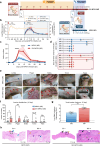The pathogenicity and multi-organ proteomic profiles of Mpox virus infection in SIVmac239-infected rhesus macaques
- PMID: 40819122
- PMCID: PMC12357934
- DOI: 10.1038/s41467-025-62919-z
The pathogenicity and multi-organ proteomic profiles of Mpox virus infection in SIVmac239-infected rhesus macaques
Abstract
Mpox poses a heightened risk of severe disease and mortality among individuals with HIV, yet the molecular mechanisms and immunopathology underlying multi-organ damage caused by the mpox virus (MPXV), particularly in the context of HIV co-infection, remain poorly understood. Here, we observe increased MPXV replication, more extensive skin lesions, and impaired humoral and cellular immune responses in SIV-MPXV co-infected rhesus macaques compared to those infected with MPXV alone. Multi-organ proteomic and phosphoproteomic analyses reveals upregulation of proteins involved in immune and inflammatory pathways in skin lesions and across multiple organs, especially in immune-related tissues. Abnormal activation of DNA replication and cell cycle signaling pathways, which may contribute to enhanced viral replication, is evident in both MPXV and SIV-MPXV co-infected groups. CDK4/6 may present a potential therapeutic target to suppress MPXV replication. These comprehensive proteomic datasets offer valuable insights into the pathogenesis of MPXV in the context of SIV co-infection and support ongoing efforts to mitigate the impact of mpox.
© 2025. The Author(s).
Conflict of interest statement
Competing interests: The authors declare no competing interests.
Figures




References
-
- Ogoina, D. et al. Clinical course and outcome of human monkeypox in nigeria. Clin. Infect. Dis.71, e210–e214 (2020). - PubMed
-
- Taylor, L. WHO and African CDC declare mpox a public health emergency. BMJ386, q1809 (2024). - PubMed
-
- CDC), A. C. f. D. C. a. P. A. Africa CDC declares mpox a public health emergency of continental security, mobilizing resources across the continent. (2024).
-
- Thornhill, J. P., Gandhi, M. & Orkin, C. Mpox: The reemergence of an old disease and inequities. Annu. Rev. Med.75, 159–175 (2024). - PubMed
-
- WHO. Global Mpox Trends. https://worldhealthorg.shinyapps.io/mpx_global/. (2024).
MeSH terms
Substances
LinkOut - more resources
Full Text Sources

